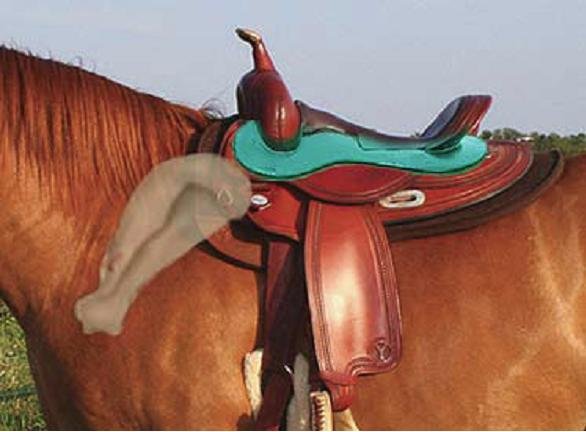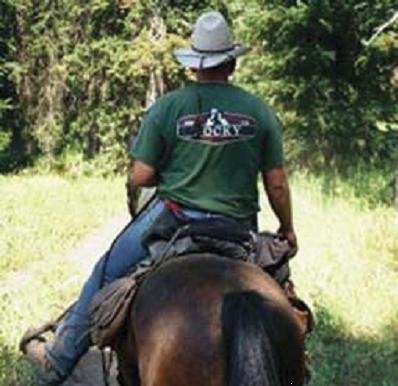 |
|  |
 |
 |
Saddle Fitting Continued....
|
Sweat Patterns
- Sweat patterns can give an indication of how the saddle fits. Ideally, the sweat pattern will be even, without dry areas that indicate pressure points, areas where the hair has been rubbed off, ruffled hair or swirl marks than indicate excessive movement.
- Keep in mind that damage from past saddle fit issues can cause areas of dry spots or white marks.
-
Is most of the wear in the middle, and none on the ends? Is your horse's back dry in the middle and wet under the pommel and cantle? The saddle may have too much rock to it. (Place your saddle on your horse's back without a pad and see if it rocks forward and back) Rocking can sometimes be corrected with pads or shims.
-
If your saddle is bridging, your horse will be dry under the cantle and pommel and wet in the middle. This means the saddle bars are only making contact at the front and the rear, putting pressure at the front and rear only and not down the middle of the back, creating pressure points against the horse. This can lead to serious damage and soreness. A bridge pad is needed to bridge the gap between the horse’s back and tree bars and to effectively distribute the rider’s weight.
-
If your horse's back is wet all over under the saddle except near the withers, on or behind the shoulders, it usually means your saddle is too narrow. Sometimes though it could be a saddle is too wide. To determine which it is, look at your saddle to see if it is level on the horse. If it sits down low in the front end, it's probably too wide. If it sits up in the front, it's too narrow.
|
.
|
|
Saddle Pads
-
You can tell by the hair, dirt, or wear marks where the most pressure is on the horse.
-
Is most of the wear in the middle, and none on the ends? The saddle may be rocking - excessive rocking can be corrected with pads or shims.
-
Is the middle of the pad under the bar not as dirty or compressed as the ends? That could be an indication of bridging. If you think there is even a chance there is any bridging (pressure at the front and back of the bars) it is best to correct with a shim or bridge pad in the center of the bars to correct the problem.
-
Is your pad dry or packed down by the withers and wet everywhere else? That could mean your saddle is too tight, or narrow.
-
Is your pad roughed up or worn on the loin area? This oftentimes means the saddle swishes side to side while your horse walks, which means your saddle doesn't fit. Most of the time the saddle is too wide, but it could just be the wrong shape for that horse.
|
| |
|
| Avoid Common Mistakes of Saddle Fitting |
|
|
|
|
Saddle Placement
The front of the bar of the saddle tree (approximately the front edge of the concho) should be behind the shoulder blade (scapula) to allow for freedom of movement.
Placing the saddle too far forward over the scapula can cause unnecessary rubbing and pressure (white spots). The blanket or pad and the skirt of the saddle can cover the back of the scapula but the bars of the tree must be behind the shoulder blade.
Front Cinch Usage
|
|
Bars of the tree should settle behind the horse’s scapula. This is important as a saddle will travel back/ forward to settle into this sweet spot.
To find your saddle's proper placement, position it a little farther forward than you think it should go and push down on the saddle while wiggling it. If it fits your horse, the saddle should slide back and settle into the sweet spot for you.
|

Proper saddle placement
|
| |
|
|
Flank Cinch Usage
|
|
Pads and Padding
Cleanliness
|
-
Keep your horse’s back clean - dirt is abrasive. The movement of the horse and the rider creates movement of the saddle. The abrasiveness and movement causes skin irritation. Your horse’s back should be cleaned, brushed, vacuumed or washed before and after riding to remove sweat and dirt.
- Keep your blankets, pad, and cinch clean. The dirt is very abrasive and can cause sores or objections from your horse!
Conditioning
|
-
A horse is no different from a human athlete; horses get sore muscles when they are not in shape. Long trail rides, once a month barrel races, or competitions when a horse is not in the proper condition will make a horse’s back sore. When you apply pressure to an unconditioned horse’s back you will get swelling which accentuates or creates saddle fit issues. If you feel heat or swelling after long or strenuous use of your horse, let his back rest and heal.
-
Do not jump to the conclusion that your saddle does not fit if you find your horses back is sore due to being in poor condition. A horse’s back will drop when it is not in condition or is overweight. When this happens, bridging of the saddle tree can occur. Strong abdominal muscles support and straighten the back of both the horse and the rider. Daily riding and conditioning will keep your horse’s back tough and strong.
|
|
Rider Balance
-
Consider how you sit in the saddle. For the tree to function properly you must sit balanced in the saddle. If you are sitting in the saddle like a recliner with your legs out in front, you are exerting twice as much force on the back of the bars, and digging the bars into the horse’s loins. The rider must sit in a balanced position, vertically with your legs under you - this will allow the bars of the tree to function properly, spreading pressure equally front to back.
-
Heavy riders require the tree to distribute more pounds per square inch on the horse. For this reason, proper saddle fit, a good pad, and equitation is even more important with the heavy rider.
|

How NOT to sit in the saddle. Sitting
balanced benefits your horse and helps
you ride better too.
|
| |
|
|
Improper saddle fit prevents the rider’s weight from being distributed evenly through the bars of the saddle tree, resulting in pressure points, rub marks, soreness, or the development of white spots. Your horse’s attitude under saddle can clue you in to a problem, but keep in mind that many a good horse will endure an ill fitting saddle until the damage becomes unbearable before complaining. So be proactive in evaluating good saddle fit for your horse.
Your horse is one of the best indicators of Good Fit so be aware of changes in your horse’s attitude or performance
|
| |
|
| Saddle fitting is a process. Arm yourself with information, talk to your retailer, professional or the saddle manufacturer for information on the product you are interested in. Remember - it’s just common sense saddle fitting, so go out and ride. |
| |
|
| |
|
| |
|
<<<Previous Page
|
 |
|
|
|
 |